Andalusia covers almost the entire bottom quarter of Spain. Moreover, for many it’s the “real” Spain, of flamenco, tapas, the Alhambra, lilting guitars and fighting bulls, and, of course, the Costa del Sol.
Those of us who first came to Spain for the beaches of Nerja, Marbella or Fuengirola find after a while that the interior – just a few minutes’ drive from the beaches – is even more exciting than the coast…
Spain Property Guides can put you in touch with the very best lawyers, estate agents and international payments specialists in Spain, for total peace of mind when buying in Spain. Get in touch with your Golden Three here.
When you think of Andalusia you might well name the Costa del Sol towns of the region: Málaga, Benalmádena, Marbella or Torremolinos, for example. These have tempted property buyers and retirees from across the world – but especially chillier, greyer northern countries – to a climate which offers 300 sunny days a year, comfortable warm temperatures, the sea, the beaches and the nightlife.
However, travel a short distance inland into Andalusia and you will find the cities of Seville, Córdoba and Granada, nicknamed “The Golden Triangle”. These wonderful cities also offer a great way of life, with traditional Spanish culture, delicious food and natural beauty.
Whether you buy on the coast or inland, life is spent outside most of the year, with average temperatures from March to December at a minimum of 15º and a maximum of 29º.
SEARCH for properties in Andalusia via our property portal
Let’s check out some places to buy here.
Seville
We should start here. Seville is the capital city of the province of Seville, and what a delight it is! Its unique culture offers something for all tastes and interests. Owing to its fascinating history, the city of today is an eclectic mix of Moorish and Catholic architecture and tradition.
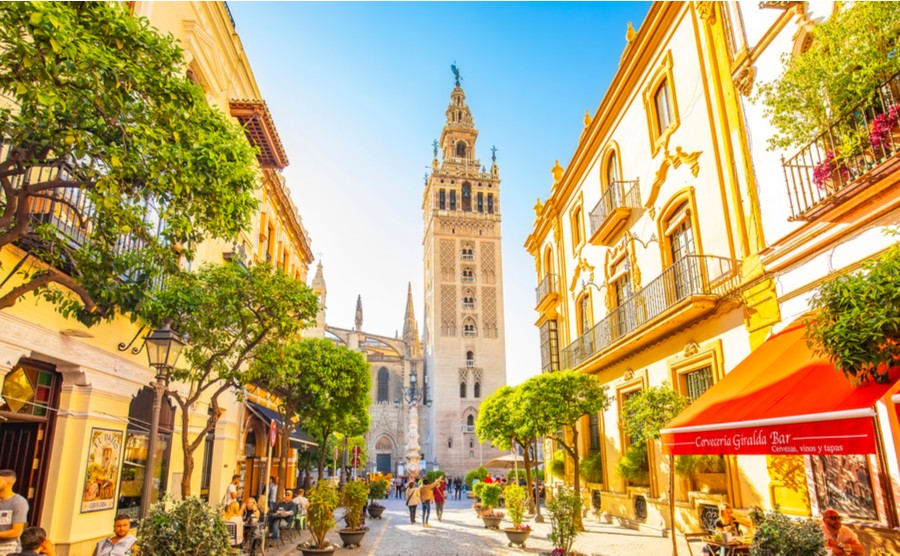
Seville (Arcady / Shutterstock.com)
It is a city which works at a slow pace; nothing feels too frenetic despite it being the capital. Of course, there are tourists, actually quite a lot of them, but most places don’t get too overcrowded, except perhaps the Real Alcazar.
The great thing is that just a short distance from these is real “local” Seville, full of tapas bars and restaurants, good shopping and parks where the people wander and sit in the shade watching the world go by. It is quite a compact centre allowing you to walk almost everywhere within 30 minutes.
Quite Moorish
Having enjoyed 800 years of Moorish rule, there is much of that culture and religion to be seen within Seville. It adds greatly to the vibe of the city, with courtyards, orange trees, wonderful ancient tiling and typical Moorish buildings with arches and fretwork.
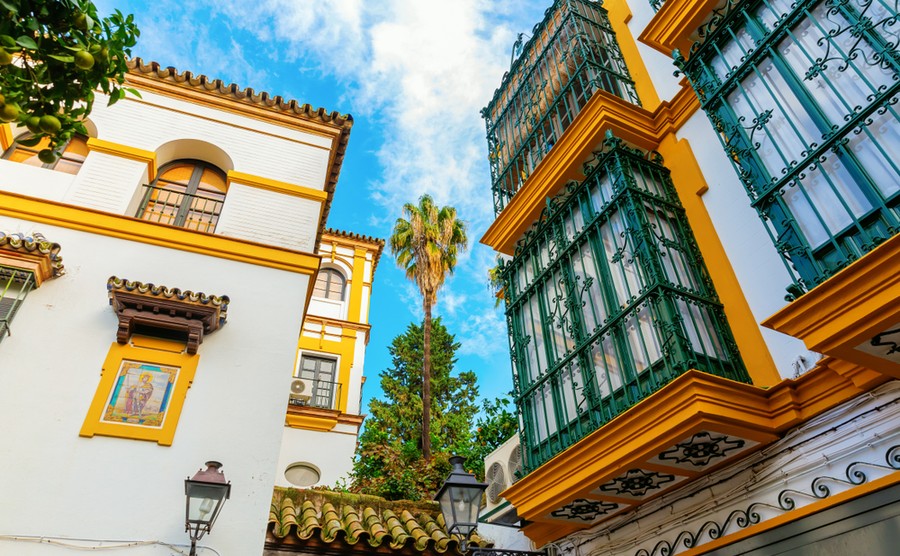
The Santa Cruz district of Seville
One of the main events in the Seville calendar is the Feria de Sevilla which happens in April. The locals call it “the world’s most colourful party” and it is a lovely festival. Houses and doorways are lit up and the whole city becomes a city of lights with literally millions of lightbulbs shining.
All year, however, the locals are friendly and welcoming to their large foreign community. It’s a city which caters for families, the kind of place where whole families are out eating together at midnight. There is plenty of nightlife for the older generation too, with sophisticated flamenco clubs and plenty of live music.
If you’re preparing to come over to Spain to look at properties, make sure you know what to look for by reading our free guide, Your Viewing Trip.
The closest beach is Matalascañas, Huelva, about 70 minutes’ drive from the city. The coast here is dominated by the Doñana National Park and has miles of golden sand. There are many other lovely beaches within an hour or two’s drive.
Properties and practicalities of Seville
Seville has its own international airport, the sixth busiest in Spain, with flights from 42 countries in Europe and North Africa.
For those coming from further afield, such as the USA, Seville is so well connected, just 2.5 hours’ fast train from Madrid and less than two from Málaga. Fast trains also run from Cordoba, Zaragoza and Barcelona to Seville.
The city sits astride the only navigable river in Spain, the Guadalquivir, allowing cruise ships almost to the city centre. It is well connected by road too, with various motorways connecting to other major cities such as Málaga, Granada, Córdoba and Madrid.
For properties, as a city of 700,000 people there are plenty of places to buy, either within the city itself or nearby. Apartments start at around €107,000 up to €1,700,000 and terraced houses from €50,000 to €4,000,000.
Good neighbourhoods to start your search include the old Jewish Quarter, Barrio Santa Cruz, the quaint homes and bustling markets of Triana, the uber-hip Alameda or more upscale El Arenal.
Córdoba
This delightful city is known for two main attractions. First is the glorious Mezquita, the Great Mosque, now a UNESCO Heritage Site. Second is the famous “patio festival”, when all the courtyards, often hidden from view on normal days, and every corner of the city becomes a riot of colour with pots of geraniums decorating the whitewashed walls.
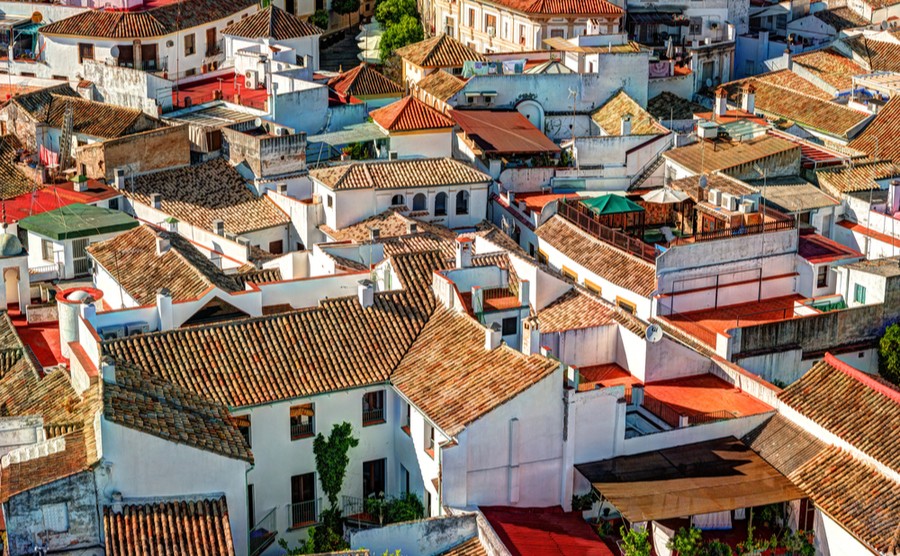
Warm, friendly and liveable, Córdoba
The Romans were here long before the Moors and a Roman bridge, temple and mausoleum, forum and amphitheatre are in the city. The Mezquita today is a Catholic church within the building but most of the original walls are still intact. There are many other beautiful examples of Moorish architecture to enjoy and an interesting Jewish quarter.
Living in Córdoba today offers a really laid-back lifestyle. Since it is some two hours from the coast, it enjoys a less commercial atmosphere but that’s not to say it doesn’t have good shopping, wonderful tapas bars, squares teaming with restaurants and an exciting nightlife.
However, tourism is different here than on the Costa del Sol as it tends to be more cultural. Winters are mild, summers are hot and March to May sees the best of the weather with sunny, dry days and nights and comfortable temperatures.
Away from the crowded coast you will find wonderful countryside, for those who like hiking, mountain biking, birdwatching and other rural pursuits.
Kick-start your search for properties in Andalusia
Properties and practicalities of Córdoba
The cost of living in Córdoba is very affordable. For example, it has a reliable and inexpensive public transport system. It feels a much smaller city than its population of 350,000 might suggest but it has all the modern amenities you would look for. There is a small British community here, although it would be useful to speak a little Spanish to help you settle in.
The airports of Seville and Málaga are both within easy reach of Córdoba and there are excellent train and road connections. Fast trains from Madrid take less than two hours and from Seville just 45 minutes.
For around €200,000 you can buy a two to three bedroom apartment. For larger houses, you may want to try the wider province rather than in the city itself and start at about the same price up to €550,000.
Make your integration into Spain as smooth as possible. Read our free Emigration Guide to find out everything you need to know about moving to Spain.
Granada
The third corner of the Golden Triangle is the city of Granada, nestled in the foothills of the Sierra Nevada mountains and 70 kilometres from the coast. It is a spectacular city, with peaceful patios and squares. Its most beautiful buildings are the world famous Alhambra and the Generalife – Moorish palaces where water features and plants recreate an oasis.
Like the other two cities of the triangle, Granada is hot in summer but it is colder in winter due to its proximity to the mountains. The advantage of its location though is that the ski slopes begin just 31 kilometres from the city.
There is a strong Moorish and Jewish influence in the gastronomy of this part of Spain and Granada is no exception with lots of dishes containing cinnamon, honey, almonds, coriander and cumin. Culturally, there is a lot going on in the city with numerous festivals and concerts.
Granada has its own airport but it only accepts national flights so you would need to fly to Madrid or Málaga first and then take a domestic flight to Granada itself. You can also get there by train from both these cities, in three hours from Madrid or on the bus from Seville or Málaga, the latter being about one hour from Granada.
Expect to pay from €200,000 to €600,000 for apartments in Granada, depending on the district.
Also consider…
Beyond the two main cities, there are many other interesting, slightly unusual places to discover in Andalusia.
Antequera
Just 45 minutes’ by road from Málaga is Antequera. It is all of Andalusia in one small town: cooler and less humid than Málaga but within easy reach of the culture, beaches, shopping and history that Málaga offers. In winter it can get cold but the climate is dry so both the heat of the summer and the cool of the winter are more than bearable.
The old town being almost totally residential, life in Antequera happens below in the little squares and side streets, in tapas bars and restaurants. Culturally, it is very Andalusian and still retains a bullring which is a feature as you enter the town.
It also has a wonderful Natural Park close by, the Torcal de Antequera, renowned for its strange and fascinating land formations.
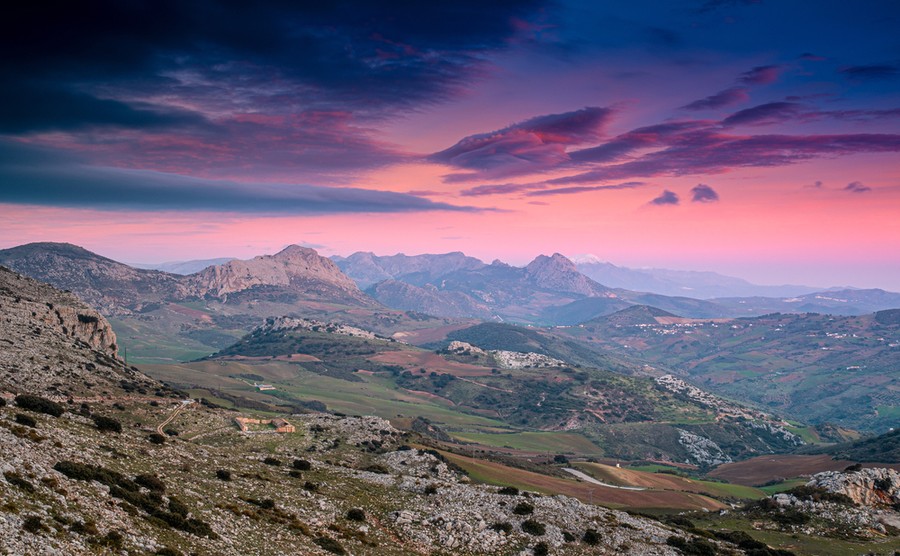
Torcal de Antequera nature reserve
There is plenty of fauna here, the Spanish Ibex being just one example. As if this weren’t enough to tempt you, there are five lakes in the area, known as the Embalses del Guadalhorce. These have clean water in which to swim, fish, canoe or sail as well as shady pines, ideal for a picnic.
The population of around 45,000 includes a small expat community, mostly living in the surrounding area. There is a large shopping centre on the edge of town with an excellent variety of outlets and once a month the cinema has films in English.
If you’re thinking of a holiday home, why not pool your resources and buy with family? Read our guide, Buying Abroad with Family to find out how to halve the cost and double the fun!
Fly into Málaga airport, 60 kilometres away, then take a bus from Málaga Bus station. They are frequent and the journey takes around an hour. There is also a train from Málaga to Antequera Santa Ana Station, but note that this is 17 kilometres from the town so you need to take a taxi from there.
You can find apartments from under €50,000 upwards and detached houses up €2,500,000.
CHOOSE your Andalusian property here
Jerez de la Frontera
Another very Andalusian town is Jerez de la Frontera, the centre of all things to do with sherry. If you have been watching the Amazon Prime series The Vineyard, it has some wonderful shots of the town and is based on characters in the 1850s who have a sherry business there.
The old town has a Moorish fortress dominating it and, apart from sherry, is famous for the Real Escuela Andaluza del Arte Ecuestre, the Royal Andalusian School of Equestrian Art. This is one of the most esteemed riding schools in the world.
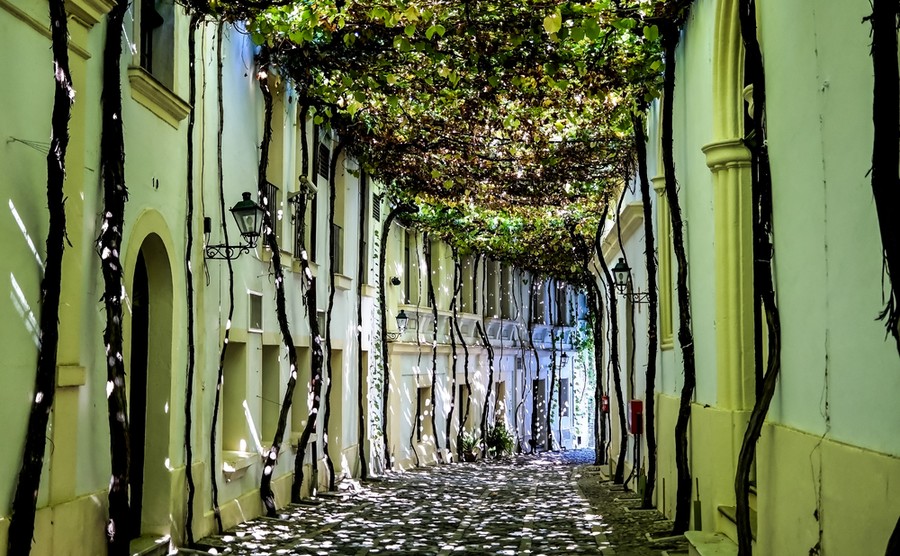
A cool and green street in Jerez, like a well-chilled sherry
It’s probably important to have some knowledge of Spanish as there aren’t all that many British people living in the town. Speaking to the locals helps to make you feel part of the local scene and although some will certainly speak English, many will not. The tapas bars and sherry bodegas contribute to a lively ambience but it is a safe town. It is still quite traditional which will suit some and the people are somewhat set in their ways but it makes for a comfortable Andalusian way of life.
It enjoys mild winters and warm summers with more than 3200 hours of sunshine a year.
Jerez has an international airport, served by Ryanair from the UK. There are trains from Seville and Cádiz but it’s not so easy from Málaga. Trains also run from Madrid and Barcelona.
An apartment will start at €125,000 up to €700,000 and houses to €3,500,000.











